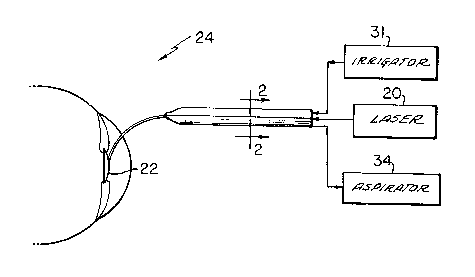Une partie des informations de ce site Web a été fournie par des sources externes. Le gouvernement du Canada n'assume aucune responsabilité concernant la précision, l'actualité ou la fiabilité des informations fournies par les sources externes. Les utilisateurs qui désirent employer cette information devraient consulter directement la source des informations. Le contenu fourni par les sources externes n'est pas assujetti aux exigences sur les langues officielles, la protection des renseignements personnels et l'accessibilité.
L'apparition de différences dans le texte et l'image des Revendications et de l'Abrégé dépend du moment auquel le document est publié. Les textes des Revendications et de l'Abrégé sont affichés :
| (12) Brevet: | (11) CA 1301853 |
|---|---|
| (21) Numéro de la demande: | 1301853 |
| (54) Titre français: | METHODE ET APPAREIL POUR L'ABLATION ET LE RETRAIT DES CATARACTES |
| (54) Titre anglais: | METHOD AND APPARATUS FOR ABLATING AND REMOVING CATARACT LENSES |
| Statut: | Périmé et au-delà du délai pour l’annulation |
| (51) Classification internationale des brevets (CIB): |
|
|---|---|
| (72) Inventeurs : |
|
| (73) Titulaires : |
|
| (71) Demandeurs : | |
| (74) Agent: | MOFFAT & CO. |
| (74) Co-agent: | |
| (45) Délivré: | 1992-05-26 |
| (22) Date de dépôt: | 1987-12-17 |
| Licence disponible: | Oui |
| Cédé au domaine public: | S.O. |
| (25) Langue des documents déposés: | Anglais |
| Traité de coopération en matière de brevets (PCT): | Non |
|---|
| (30) Données de priorité de la demande: | ||||||
|---|---|---|---|---|---|---|
|
METHOD AND APPARATUS FOR ABLATING
AND REMOVING CATARACT LENSES
Abstract of the Disclosure
A method and apparatus for removing
cataracts in which a flexible line (26) preferably 1 mm
or less in diameter is inserted through an incision
into the anterior chamber until its end is adjacent
the cataract. Coherent radiation, preferably at a
frequency between 193 and 351 nm, is coupled to the
cataract by an optical fiber (28) in the line (26).
An irrigation sleeve (30) provided about the fiber (28)
and an aspiration sleeve (32) extending partially
around the irrigation sleeve (30) conduct irrigating
liquid to and remove ablated material from the anter-
ior chamber and form with the optical fiber (28) the
flexible line (26).
Note : Les revendications sont présentées dans la langue officielle dans laquelle elles ont été soumises.
Note : Les descriptions sont présentées dans la langue officielle dans laquelle elles ont été soumises.

2024-08-01 : Dans le cadre de la transition vers les Brevets de nouvelle génération (BNG), la base de données sur les brevets canadiens (BDBC) contient désormais un Historique d'événement plus détaillé, qui reproduit le Journal des événements de notre nouvelle solution interne.
Veuillez noter que les événements débutant par « Inactive : » se réfèrent à des événements qui ne sont plus utilisés dans notre nouvelle solution interne.
Pour une meilleure compréhension de l'état de la demande ou brevet qui figure sur cette page, la rubrique Mise en garde , et les descriptions de Brevet , Historique d'événement , Taxes périodiques et Historique des paiements devraient être consultées.
| Description | Date |
|---|---|
| Inactive : Renversement de l'état périmé | 2012-12-05 |
| Inactive : CIB désactivée | 2011-07-26 |
| Le délai pour l'annulation est expiré | 2009-05-26 |
| Lettre envoyée | 2008-05-26 |
| Inactive : TME en retard traitée | 2007-08-06 |
| Lettre envoyée | 2007-05-28 |
| Inactive : CIB dérivée en 1re pos. est < | 2006-03-11 |
| Inactive : CIB de MCD | 2006-03-11 |
| Inactive : CIB de MCD | 2006-03-11 |
| Accordé par délivrance | 1992-05-26 |
| Déclaration du statut de petite entité jugée conforme | 1992-02-10 |
Il n'y a pas d'historique d'abandonnement
| Type de taxes | Anniversaire | Échéance | Date payée |
|---|---|---|---|
| TM (catégorie 1, 6e anniv.) - petite | 1998-05-26 | 1998-03-11 | |
| TM (catégorie 1, 7e anniv.) - petite | 1999-05-26 | 1999-03-17 | |
| TM (catégorie 1, 8e anniv.) - petite | 2000-05-26 | 2000-04-14 | |
| TM (catégorie 1, 9e anniv.) - petite | 2001-05-28 | 2001-04-19 | |
| TM (catégorie 1, 10e anniv.) - petite | 2002-05-27 | 2002-04-23 | |
| TM (catégorie 1, 11e anniv.) - petite | 2003-05-26 | 2003-04-18 | |
| TM (catégorie 1, 12e anniv.) - petite | 2004-05-26 | 2004-04-27 | |
| TM (catégorie 1, 13e anniv.) - petite | 2005-05-26 | 2005-05-03 | |
| TM (catégorie 1, 14e anniv.) - petite | 2006-05-26 | 2006-05-24 | |
| Annulation de la péremption réputée | 2007-05-28 | 2007-08-06 | |
| TM (catégorie 1, 15e anniv.) - petite | 2007-05-28 | 2007-08-06 |
Les titulaires actuels et antérieures au dossier sont affichés en ordre alphabétique.
| Titulaires actuels au dossier |
|---|
| PATRICIA E. BATH |
| Titulaires antérieures au dossier |
|---|
| S.O. |